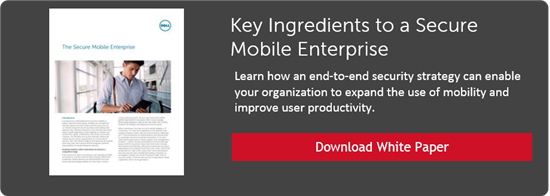Mobility is one of the most transformational technologies available today.
In just a few short years, mobile devices have evolved from cool consumer technology into mission-critical enterprise tools. Accordingly, organizations left and right are adopting bring-your-own-device (BYOD) policies to enhance productivity and collaboration while opening the doors to business transformation, competitive advantage and improved performance. In fact, a Dimensional Research survey sponsored by Dell found that 84 percent of organizations already support mobile devices on their networks.
Security is critical to a successful mobility program
Of course, the benefits of BYOD do not come free; rather, BYOD brings a host of technical challenges. Chief among them is security: 44 percent of the 1900+ global organizations surveyed in Dell’s recent Global Technology Adoption Index (GTAI) listed “fear of security breach” as the primary barrier to expanding mobile technologies within the organization. Clearly, reaping the substantial benefits of BYOD requires a carefully considered plan for network and data security.
The first hurdle is providing users with easy yet secure access to the corporate network from their personally owned smartphones and tablets. One approach is the traditional model: have IT manage all devices that access the corporate network. That way, the organization can ensure that all devices are properly maintained with current security software, browser updates and so on.
This old-school approach can work well for corporate-owned devices, but it has important drawbacks for personally owned devices, especially in verticals like education. In particular, it fails to protect the privacy of user data — the organization can see everything on a user’s personal device, from personal texts and emails to Facebook posts and browser history. Even though our culture seems to be growing ever more comfortable with sharing personal information online, most people aren’t comfortable giving their employers this unfettered window into their personal lives. As a result, this approach tends to hamper BYOD adoption, if not bring it to a grinding halt.
Secure mobile workspaces are the most secure way to implement BYOD
Fortunately, there’s a better option: secure mobile workspaces. By downloading a free app to their phone or table, employees (and other authorized users, such as partners or contractors) can establish a VPN-like connection to the corporate network. A customized workspace provides each user with access to only the resources authorized by policy, while keeping personal and corporate data separate and secure.
Specifically, a secure mobile workspace can enable authorized users to access:
- Email – A secure mobile workspace enables users to easily manage their corporate email, including attachments, from their smartphones or tablets. They can stay productive even when they’re not connected to the network, since any changes they make to the mail folder will be synchronized when they reconnect.
- Calendars – Integrated calendar functionality enables users to keep track of their meetings, manage calendar requests, create and edit meeting notices, receive notifications, and view attachments from their mobile devices.
- Contacts – Users can view and update their corporate contacts and reach out by email, voice or messaging.
- Intranet resources – Users can securely access corporate applications and data behind the firewall from a secure browser and securely store any files they download. They can find, manage, create and edit documents even when they are offline, without compromising security.
Learn more about building a secure mobile enterprise!
This secure virtual workspace is a key ingredient in a broader mobile strategy — what Dell calls the secure mobile enterprise. To learn more, read our whitepaper, “The Secure Mobile Enterprise.”




